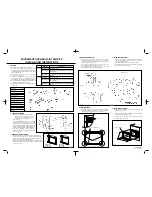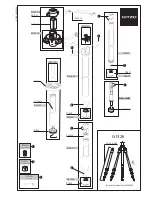KAC−12040
www.onsemi.com
14
TEST DEFINITIONS
Test Regions of Interest
Image Area ROI:
Pixel (0, 0) to Pixel (4015, 3015)
Active Area ROI:
Pixel (8, 8) to Pixel (3999, 2999)
Center ROI:
Pixel (1958, 1458) to Pixel (2057, 1557)
Only the Active Area ROI pixels are used for performance and defect tests.
Figure 11. Regions of Interest
G
B
G R
4000 (H)
y
3000 (V)
4.7
m
m Pixel
G
B
G R
G
B
G R
8
88
8
88
8
104
8
104
0,0
8,8
Test Descriptions
1) Dark Field Local Non-Uniformity Floor (DSNU_flr)
This test is performed under dark field conditions.
A 4 frame average image is collected. This image is
partitioned into 300 sub-regions of interest, each of which is
200 by 200 pixels in size. For each sub-region the standard
deviation of all its pixels is calculated. The dark field local
non-uniformity is the largest standard deviation found from
all the sub regions of interest. Units: e
−
rms (electrons rms).
2) Bright Field Global Photoresponse Non-Uniformity
(PRNU_1)
The sensor illuminated to 70% of saturation (~700 dn). In
this condition a 4 frame average image is collected. From
this 4 frame average image a 4 frame average dark image is
subtracted. The Active Area Standard Deviation is the
standard deviation of the resultant image and the Active
Area Signal is the average of the resultant image.
PRNU_1
+
100
@
ǒ
Active Area Standard Deviation
Active Area Signal
Ǔ
Units : % rms
3) Bright Field Global Peak to Peak Non-Uniformity
(PRNU_2)
This test is performed with the sensor uniformly
illuminated to 70% of saturation (~700 dn), a 4 frame
average image is collected and a 4 frame averaged dark
image is subtracted. The resultant image is partitioned into
300 sub regions of interest, each of which is 200 by
200 pixels in size. The average signal level of each sub
regions of interest (sub-ROI) is calculated.
The highest sub-ROI average (Maximum Signal) and the
lowest sub-ROI average (Minimum Signal) are then used in
the following formula to calculate PRNU_2.
PRNU_2
+
100
@
ǒ
Max. Signal
*
Min. Signal
Active Area Signal
Ǔ
Units : % pp
4) Dark Field Defect Test
This test is performed under dark field conditions.
The sensor is partitioned into 300 sub regions of interest,
each of which is 128 by 128 pixels in size. In each region of
interest, the median value of all pixels is found. For each
region of interest, a pixel is marked defective if it is greater
than or equal to the median value of that region of interest
plus the defect threshold specified in the Defect Definition
Table section.
5) Bright Field Defect Test
This test is performed with the imager illuminated to
a level such that the output is at approximately 700 dn.
The average signal level of all active pixels is found.
The bright and dark thresholds are set as:
Dark Defect Threshold = Active Area Signal
⋅
Threshold
Bright Defect Threshold = Active Area Signal
⋅
Threshold
The sensor is then partitioned into 300 sub regions of
interest, each of which is 128 by 128 pixels in size. In each
region of interest, the average value of all pixels is found.
For each region of interest, a pixel is marked defective if it
is greater than or equal to the median value of that region of
interest plus the bright threshold specified or if it is less than


















